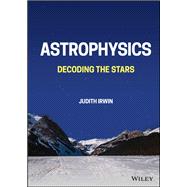This is a balanced textbook presenting the theory and observations of stars and their evolution—a cornerstone of Astrophysics.
Astrophysics: Decoding the Stars is a companion volume to Astrophysics: Decoding the Cosmos from astrophysics teacher and researcher, Professor Judith Irwin. The text presents an accessible, student-friendly guide to the key theories and principles of stars, emphasizing the close connection between observation and theory.
To aid in reader comprehension, the text includes online resources and problems at the end of each chapter. Many highlighted boxes summarize key concepts or point to example stars that can be seen with the naked eye. The text focuses on physical concepts, but it also refers to the results of numerical models using online resources.
Sample topics covered in Astrophysics: Decoding the Stars include:
- The Sun, gaseous and radiative processes
- Stellar interiors, energy transport mechanisms, stellar cores and nuclear energy generation, the global energy budget, timescales, and stability
- Observational constraints, variable stars, and star formation from molecular clouds to the ZAMS
- Evolutionary tracks on the HR diagram for stars of different masses, and how stars end their lives
- Stellar remnants — white dwarfs, neutron stars and pulsars, and black holes
Astrophysics: Decoding the Stars is a highly useful textbook resource for second- to fourth-year undergraduate students pursuing an Astrophysics program, along with Physics undergraduates who have opted to take stellar structure and evolution as part of their program. It will also be useful for new graduate students who want a solid grounding in stellar astrophysics.








